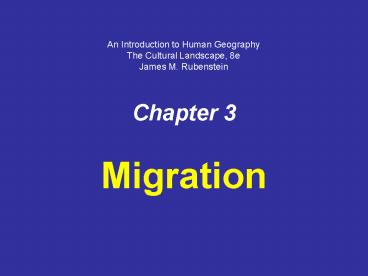Migration - PowerPoint PPT Presentation
1 / 22
Title:
Migration
Description:
An Introduction to Human Geography The Cultural Landscape, 8e James M. Rubenstein Chapter 3 Migration Example Question In the early twenty-first century, the largest ... – PowerPoint PPT presentation
Number of Views:172
Avg rating:3.0/5.0
Title: Migration
1
Chapter 3
An Introduction to Human Geography The Cultural
Landscape, 8e James M. Rubenstein
- Migration
2
Example Question
- In the early twenty-first century, the largest
number of refugees is located on which of the
following continents? - Africa
- Australia
- Europe
- North America
- South America
3
Refugees Sources and destinations
Fig. 3-1 Major source and destination areas of
both international and internal refugees.
4
Why People Migrate
- Reasons for migrating
- Push and pull factors
- Economic Cultural Environmental
- Intervening obstacles
- Distance of migration
- Internal migration
- International migration
- Characteristics of migrants
- Gender
- Family status
5
Global Migration Patterns
Fig. 3-2 The major flows of migration are from
less developed to more developed countries.
6
Global Migration Activity
- Utilizing the map, please describe at least 1
push or pull factor for each migration stream
100,000 or more. - Remember that there are 3 major kinds of push and
pull factors. (90)
7
Migration Patterns
- Global migration patterns
- U.S. migration patterns
- Colonial immigration
- 19th century immigration
- Recent immigration
- Impact of immigration on the U.S.
- Legacy of European migration
- Undocumented immigration
- Destination of immigrants within the U.S.
8
Net Migration (per population)
Fig. 3-3 Net migration per 1,000 population. The
U.S. has the largest number of immigrants, but
other developed countries also have relatively
large numbers.
9
Migration to U.S., by region of origin
Fig. 3-4 Most migrants to the U.S. were from
Europe until the 1960s. Since then, Latin America
and Asia have become the main sources of
immigrants.
10
Migration from Asia to the U.S.
Fig. 3-5 Migration in 2001. The largest numbers
of migrants from Asia come from India, China, the
Philippines, and Vietnam.
11
Migration from Latin America to the U.S.
Fig. 3-6 Mexico has been the largest source of
migrants to the U.S., but migrants have also come
from numerous other Latin American nations.
12
Undocumented ImmigrationMexico to Arizona
Fig. 3-7 The complex route of one group of
undocumented migrants from a small village north
of Mexico City to Phoenix, Arizona.
13
U.S. States as Immigrant Destinations
Fig. 3-8 California is the destination of about
25 of all U.S. immigrants another 25 go to New
York and New Jersey. Other important destinations
include Florida, Texas, and Illinois.
14
Obstacles to Migration
- Immigration policies of host countries
- U.S. quota laws
- Temporary migration for work
- Time-contract workers
- Economic migrants or refugees?
- Cultural problems living in other countries
- U.S. attitudes to immigrants
- Attitudes to guest workers
15
Case Studies
- You need to provide a specific example (country,
situation) for each of the following. - Economic Push Factor
- Economic Pull Factor
- Cultural Push Factor
- Cultural Pull Factor
- Environmental Push Factor
- Environmental Pull Factor
16
Guest Workers in Europe
Fig. 3-9 Guest workers emigrate mainly from
Eastern Europe and North Africa to work in the
wealthier countries of Western Europe.
17
Emigration from China
Fig. 3-10 Various ethnic Chinese peoples have
distinct patterns of migration to other Asian
countries.
18
Migration of Vietnamese Boat People
Fig. 3-11 Many Vietnamese fled by sea as
refugees after the war with the U.S. ended in
1975. Later boat people were often considered
economic migrants.
19
Migration within a Country
- Migration between regions of a country
- Migration between regions within the U.S.
- Migration between regions in other countries
- Migration within one region
- Rural-urban migration
- Urban-suburban migration
- Migration from metropolitan to nonmetropolitan
regions
20
Center of Population in the U.S.
Fig. 3-12 The center of U.S. population has
consistently moved westward, with the population
migration west. It has also begun to move
southward with migration to the southern sunbelt.
21
Interregional Migration in the U.S.
Fig. 3-13 Average annual migrations between
regions in the U.S. in 1995 and in 2000.
22
Intraregional Migration in the U.S.
Fig. 3-14 Average annual migration among urban,
suburban, and rural areas in the U.S. during the
1990s. The largest flow was from central cities
to suburbs.

